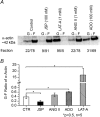Vasoactive agonists exert dynamic and coordinated effects on vascular smooth muscle cell elasticity, cytoskeletal remodelling and adhesion
- PMID: 24445320
- PMCID: PMC3961085
- DOI: 10.1113/jphysiol.2013.264929
Vasoactive agonists exert dynamic and coordinated effects on vascular smooth muscle cell elasticity, cytoskeletal remodelling and adhesion
Abstract
In this study, we examined the ability of vasoactive agonists to induce dynamic changes in vascular smooth muscle cell (VSMC) elasticity and adhesion, and tested the hypothesis that these events are coordinated with rapid remodelling of the cortical cytoskeleton. Real-time measurement of cell elasticity was performed with atomic force microscopy (AFM) and adhesion was assessed with AFM probes coated with fibronectin (FN). Temporal data were analysed using an Eigen-decomposition method. Elasticity in VSMCs displayed temporal oscillations with three components at approximately 0.001, 0.004 and 0.07 Hz, respectively. Similarly, adhesion displayed a similar oscillatory pattern. Angiotensin II (ANG II, 10(-6) M) increased (+100%) the amplitude of the oscillations, whereas the vasodilator adenosine (ADO, 10(-4) M) reduced oscillation amplitude (-30%). To test whether the oscillatory changes were related to the architectural alterations in cortical cytoskeleton, the topography of the submembranous actin cytoskeleton (100-300 nm depth) was acquired with AFM. These data were analysed to compare cortical actin fibre distribution and orientation before and after treatment with vasoactive agonists. The results showed that ANG II increased the density of stress fibres by 23%, while ADO decreased the density of the stress fibres by 45%. AFM data were supported by Western blot and confocal microscopy. Collectively, these observations indicate that VSMC cytoskeletal structure and adhesion to the extracellular matrix are dynamically altered in response to agonist stimulation. Thus, vasoactive agonists probably invoke unique mechanisms that dynamically alter the behaviour and structure of both the VSMC cytoskeleton and focal adhesions to efficiently support the normal contractile behaviour of VSMCs.
Figures










Comment in
-
Restless cell syndrome.J Physiol. 2014 Mar 15;592(6):1175-6. doi: 10.1113/jphysiol.2014.271759. J Physiol. 2014. PMID: 24634017 Free PMC article. No abstract available.
Similar articles
-
Coordination of fibronectin adhesion with contraction and relaxation in microvascular smooth muscle.Cardiovasc Res. 2012 Oct 1;96(1):73-80. doi: 10.1093/cvr/cvs239. Epub 2012 Jul 16. Cardiovasc Res. 2012. PMID: 22802110 Free PMC article.
-
Membrane cholesterol and substrate stiffness co-ordinate to induce the remodelling of the cytoskeleton and the alteration in the biomechanics of vascular smooth muscle cells.Cardiovasc Res. 2019 Jul 1;115(8):1369-1380. doi: 10.1093/cvr/cvy276. Cardiovasc Res. 2019. PMID: 30395154 Free PMC article.
-
Vascular smooth muscle cell stiffness and adhesion to collagen I modified by vasoactive agonists.PLoS One. 2015 Mar 6;10(3):e0119533. doi: 10.1371/journal.pone.0119533. eCollection 2015. PLoS One. 2015. PMID: 25745858 Free PMC article.
-
Functional Remodeling of the Contractile Smooth Muscle Cell Cortex, a Provocative Concept, Supported by Direct Visualization of Cortical Remodeling.Biology (Basel). 2022 Apr 26;11(5):662. doi: 10.3390/biology11050662. Biology (Basel). 2022. PMID: 35625390 Free PMC article. Review.
-
Connections between the cell cycle, cell adhesion and the cytoskeleton.Philos Trans R Soc Lond B Biol Sci. 2019 Aug 19;374(1779):20180227. doi: 10.1098/rstb.2018.0227. Epub 2019 Jul 1. Philos Trans R Soc Lond B Biol Sci. 2019. PMID: 31431178 Free PMC article. Review.
Cited by
-
Modification of Fibronectin by Non-Enzymatic Glycation Impairs K+ Channel Function in Rat Cerebral Artery Smooth Muscle Cells.Front Physiol. 2022 Jun 27;13:871968. doi: 10.3389/fphys.2022.871968. eCollection 2022. Front Physiol. 2022. PMID: 35832482 Free PMC article.
-
Potential Role of Antihypertensive Medications in Preventing Excessive Arterial Stiffening.Curr Hypertens Rep. 2018 Jul 6;20(9):76. doi: 10.1007/s11906-018-0876-9. Curr Hypertens Rep. 2018. PMID: 29980951 Free PMC article. Review.
-
Coronary remodeling and biomechanics: Are we going with the flow in 2020?Am J Physiol Heart Circ Physiol. 2021 Feb 1;320(2):H584-H592. doi: 10.1152/ajpheart.00634.2020. Epub 2020 Nov 13. Am J Physiol Heart Circ Physiol. 2021. PMID: 33185115 Free PMC article. Review.
-
Gene expression modulation in human aortic smooth muscle cells under induced physiological mechanical stretch.Sci Rep. 2024 Dec 28;14(1):31147. doi: 10.1038/s41598-024-82495-4. Sci Rep. 2024. PMID: 39732782 Free PMC article.
-
Augmented vascular smooth muscle cell stiffness and adhesion when hypertension is superimposed on aging.Hypertension. 2015 Feb;65(2):370-7. doi: 10.1161/HYPERTENSIONAHA.114.04456. Epub 2014 Dec 1. Hypertension. 2015. PMID: 25452471 Free PMC article.
References
-
- Butt H-J, Jaschke M. Calculation of thermal noise in atomic force microscopy. Nanotechnology. 1995;6:7.
-
- De Deyne PG. Application of passive stretch and its implications for muscle fibres. Phys Ther. 2001;81:819–827. - PubMed
Publication types
MeSH terms
Substances
Grants and funding
LinkOut - more resources
Full Text Sources
Other Literature Sources
Miscellaneous

